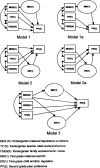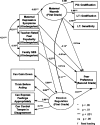Maternal depressive symptoms and child social preference during the early school years: mediation by maternal warmth and child emotion regulation
- PMID: 21080053
- PMCID: PMC3066397
- DOI: 10.1007/s10802-010-9468-0
Maternal depressive symptoms and child social preference during the early school years: mediation by maternal warmth and child emotion regulation
Abstract
This longitudinal study examined processes that mediate the association between maternal depressive symptoms and peer social preference during the early school years. Three hundred and fifty six kindergarten children (182 boys) and their mothers participated in the study. During kindergarten, mothers reported their level of depressive symptomatology. In first grade, teachers rated children's emotion regulation at school and observers rated the affective quality of mother-child interactions. During second grade, children's social preference was assessed by peer nomination. Results indicated that mothers' level of depressive symptomatology negatively predicted their child's social preference 2 years later, controlling for the family SES and teacher-rated social preference during kindergarten. Among European American families, the association between maternal depressive symptoms and social preference was partially mediated by maternal warmth and the child's emotion regulation. Although the relation between maternal depressive symptoms and children peer preference was stronger among African American families than Europrean American families, its mediation by the maternal warmth and child's emotion regulation was not found in African American families.
Figures


References
-
- Bierman K. Peer rejection: Developmental processes and intervention strategies. New York: Guilford Press; 2004.
-
- Blandon AY, Calkins SD, Keane SP, O’Brien M. Individual differences in trajectories of emotion relation processes: the effects of maternal depressive symptomatology and children’s physiological regulation. Developmental Psychology. 2008;44:1110–1123. doi: 10.1037/0012-1649.44.4.1110. - DOI - PMC - PubMed
-
- Burt KB, Van Dulmen MHM, Carlivati J, Egeland B, Sroufe LA, Forman DR, et al. Mediating links between maternal depression and offspring psychopathology: the importance of independent data. Journal of Child Psychology and Psychiatry. 2005;46:490–499. doi: 10.1111/j.1469-7610.2004.00367.x. - DOI - PubMed
MeSH terms
Grants and funding
LinkOut - more resources
Full Text Sources
Medical

